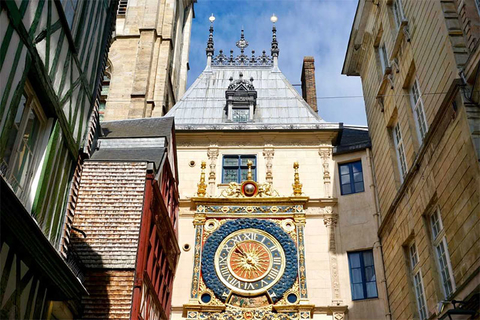Rouen is the touchstone city of the Normandy region just an hour and twenty minutes from Paris, an easy day trip.
The old quarter of the city, just a few minutes walk from the main train station, is where you want to focus your time. The focal point of the ancient quarter is the magnificent Rouen Cathedral, one of the great Gothic churches of France along with Notre Dame and Chartres. Construction of the current structure began in the 12th century and carried out in High Gothic style, which included stained glass windows, flying buttresses, and side chapels. In 1485, the extravagant Butter Tower was built, financed by the wealthy whose weakness for butter couldn’t be resisted during Lent, so their fines paid for the tower. It was designed in Flamboyant Gothic style with ribbons of limestone cascading down the sides.
Painter Claude Monet was enamored with Rouen Cathedral and painted a series of iconic works depicting the cathedral in varied weather conditions, times of day and different seasons.
Rouen is steeped in important history and closely linked with English medieval times; it’s where William the Conqueror held court and Richard the Lionheart was made the Duke of Normandy. Perhaps Rouen’s most celebrated figure is Joan of Arc, who was executed at the stake in 1431 at the age of 19. Our visit to the newly opened Joan of Arc Museum was an eclectic mix of authentic Gothic-Roman vaults and 15th century architecture, along with 3D multimedia, state of the art mapping and projections, conveying the complex and moving story of France’s most beloved saint.
After our intense history lesson of Rouen, we indulged in a long lunch at Gill, an haute cuisine, two-star Michelin restaurant. Chef Gilles Tournadre is inspired by the sea and turns out a winning menu of local seafood specialties, including roasted Brittany lobster, pan-fried sea bass with Normandy cider, and roasted sea scallops in citrus sauce. Our appetizer of cooked foie gras with pear and red wine mousseline was decadently divine and dessert, Calvados soufflé with sorbet and apple mousse, made us practically swoon. Gill is a bit of a family affair, with Tournadre’s wife Sylvie selecting the wines for the restaurant, with her extensive background as the daughter of wine growers from the Sancerre region.
In the afternoon we strolled on the pedestrian streets in the center, taking in boutiques, cafes and bookshops. Another charming feature of Rouen is the proliferation of half-timber edifices from the 12th and 13th century. The well-maintained facades feature petrified wood beams inserted with plaster in colors of marigold, tangerine, melon, mint and sea-foam blue.

The Gros Horloge, located in a Renaissance arch, is the oldest time mechanism in France, dating from 1389. The façade represents a golden sun with 24 rays shooting out against a blue background crowded with stars, measuring 2.5 meters in diameter. British painter J.M. W. Turner timelessly captured the beauty of Gros Horloge in a painting in 1832.
Curiously, the Joan of Arc Cathedral is not medieval, as one would expect, but rather a modern day church. Designed by architect Louis Arretche, the church was constructed in 1979 on the historic Place du Vieux-Marché, the former old market place of Rouen. Once inside the church, there is a striking set of 13 stained glass windows from the 1500s, the remains of the Saint Vincent Church, which was decimated during WWII, although miraculously the windows were saved. The 13 panels represent Christ’s childhood, Passion, Crucifixion and Resurrection, and life events of Saint Peter, Saint Anne and Saint Anthony of Padua.
Our last stop of the day was an unusual museum, Museé Secq des Tournelles, which is dedicated to the art of wrought iron. The collection was first amassed by its founder, Jean-Louis-Henri Le Secq Destournelles, who was trained as a painter, but later went on to become one of France’s first photographers. He was commissioned to photograph various historical monuments throughout France and during his travels, he started to collect pieces of ironwork starting in 1865. His son Henry carried on his father’s passion for collecting ironwork and donated the collection to the city of Rouen in the early 1900s. The Saint-Laurent/ Museé Secq des Tournelles was inaugurated in 1921 with immediate success. Other collectors donated their works to the museum and it now contains close to 14,000 pieces.
A five-minute walk from the Rouen Cathedral is Hotel de Bourgtheroulde, the top 5-star hotel in central Rouen. Located in a renovated, former private palace from 1532, the hotel features 78 rooms and suites designed with either contemporary design elements or traditional. The Spa du Drap d’Or pampers its guests with a gorgeous, oversized indoor pool, six treatment rooms, fitness room/gym, sauna and Turkish style steam bath.
Rouen is an hour and twenty minutes by train from Paris, leaving from the Saint Lazare station.
https://uk.voyages-sncf.com/en/#/
Gill Restaurant
8-9, quai de la Bourse, 76000 Tel.:+33 2 35 71 16 14
https://www.gill.fr/en/
Joan of Arc Museum
7, rue Saint-Romain 76000
http://us.france.fr/en/discover/visit-jeanne-darc-museum-normandy
Musée Le Secq des Tournelles
Rue Jacques-Villon
http://museelesecqdestournelles.fr/en
Hotel de Bourgtheroulde
15 Pl. de la Pucelle, 76000
Tel. +33 (0)2 35 14 50 50
http://www.hotelsparouen.com/index_english.php